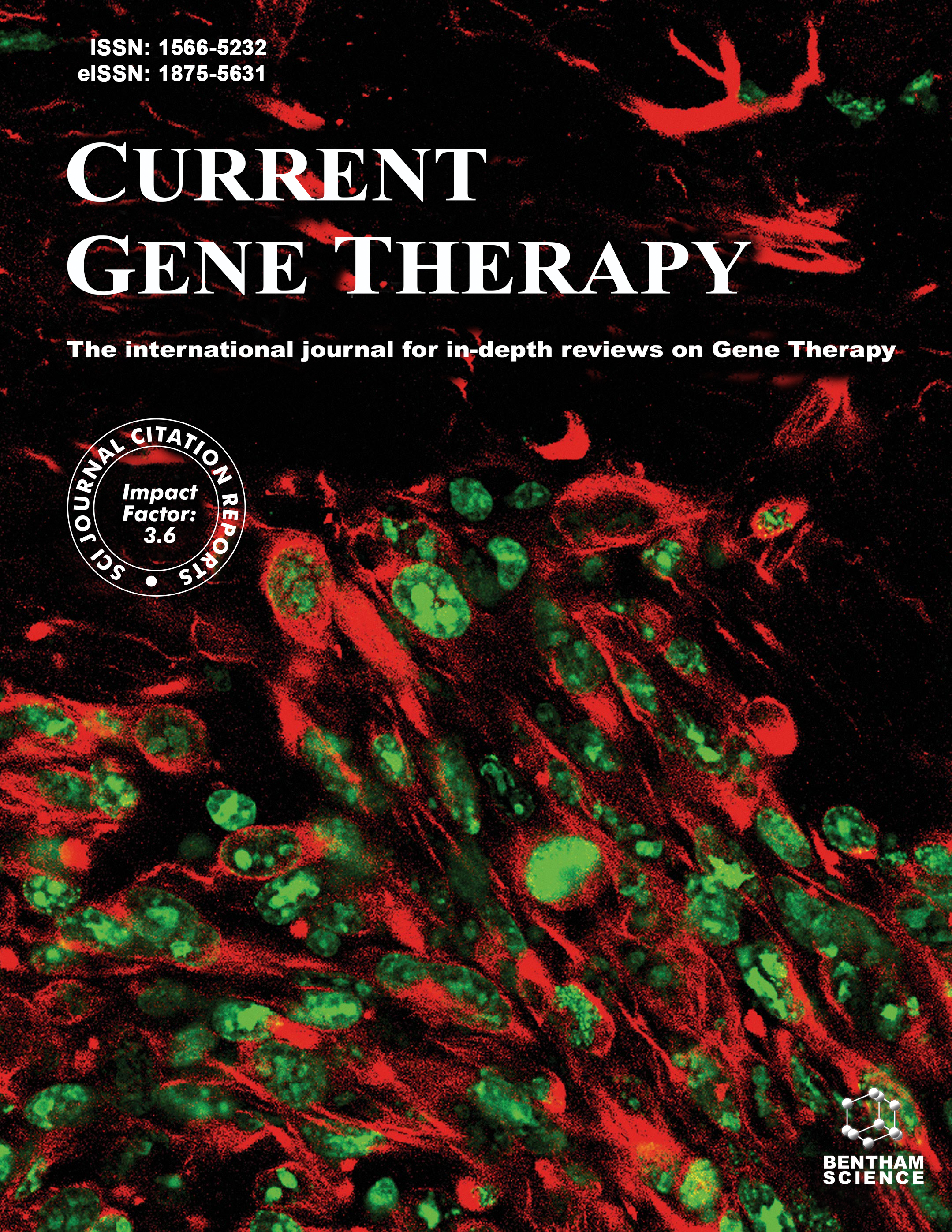- Home
- A-Z Publications
- Current Gene Therapy
- Previous Issues
- Volume 14, Issue 1, 2014
Current Gene Therapy - Volume 14, Issue 1, 2014
Volume 14, Issue 1, 2014
-
-
Targeted Genome Editing Tools for Disease Modeling and Gene Therapy
More LessThe development of custom-designed nucleases (CDNs), including zinc finger nucleases (ZFNs) and transcription activator-like effector nucleases (TALENs), has made it possible to perform precise genetic engineering in many cell types and species. More recently, clustered regularly interspaced short palindromic repeats (CRISPR)/CRISPR-associated (Cas) system has been successfully employed for genome editing. Th Read More
-
-
-
Viral Hybrid-Vectors for Delivery of Autonomous Replicons
More LessAuthors: Wenli Zhang, Claudia Hagedorn, Eric Schulz, Hans-Joachim Lipps and Anja EhrhardtGene therapeutic approaches offer great opportunities to treat genetic diseases which require long-term effects after a single administration of a customized vector. For these specific approaches the optimal vector system should combine the following features: (1) it should efficiently transport the genetic cargo into target cells in vitro or in vivo, (2) it should lead to sufficient long-term expression of the therapeutic transgene, (3) Read More
-
-
-
Gene Therapy and Cell Reprogramming For the Aging Brain: Achievements and Promise
More LessIn the central nervous system, cholinergic and dopaminergic (DA) neurons are among the cells most susceptible to the deleterious effects of age. Thus, the basal forebrain cholinergic system is known to undergo moderate neurodegenerative changes during normal aging as well as severe atrophy in Alzheimer’s disease (AD). Parkinson's disease (PD), a degeneration of nigro-striatal DA neurons is the most conspicuous reflec Read More
-
-
-
Clinical Immunotherapy of B-Cell Malignancy Using CD19-Targeted CAR T-Cells
More LessBy John MaherThe CD19 molecule is ubiquitously expressed throughout all stages of B-cell differentiation, but is not found on haemopoietic stem cells. Since most B-cell leukaemias and lymphomas retain CD19 expression, it represents an excellent target for immunotherapy of these malignant disorders. Over the past 10 years, compelling pre-clinical evidence has accrued to indicate that expression of a CD19-targeted chimeric antigen recepto Read More
-
-
-
A Novel Homologous Model for Gene Therapy of Dwarfism by Non-Viral Transfer of the Mouse Growth Hormone Gene into Immunocompetent Dwarf Mice
More LessThe possibilities for non-viral GH gene therapy are studied in immunocompetent dwarf mice (lit/lit). As expression vector we used a plasmid previously employed in immunodeficient dwarf mice (pUBI-hGH-gDNA) by replacing the human GH gene with the genomic sequence of mouse-GH DNA (pUBI-mGH-gDNA). HEK-293 human cells transfected with pUBI-mGH-gDNA produced 3.0 µg mGH/106 cells/day compared to 3.7 µg Read More
-
-
-
Genetically Redirected T Lymphocytes for Adoptive Immunotherapy of Solid Tumors
More LessAuthors: Valeria Leuci, Giulia Mesiano, Loretta Gammaitoni, Massimo Aglietta and Dario SangioloGenetic engineering of T lymphocytes to confer new antitumor specificities is a fascinating approach that may help the successful clinical translation of adoptive immunotherapy strategies. The recognition of tumor-specific antigens may be obtained inducing the membrane expression of transgene encoded antitumor T cell receptors (TCR) or chimeric antigen receptors (CAR). Few but very informative clinical trials with Read More
-
-
-
Cardiac-Specific Expression of the Hepatocyte Growth Factor (HGF) Under the Control of a TnIc Promoter Confers a Heart Protective Effect After Myocardial Infarction (MI)
More LessAuthors: Zhihui Xu, Zhengxian Tao, Zhuowen Xu, Yuefeng Yang, Hua Wang, Lisheng Wang, Zuze Wu, Qi Tan, Ningtian Zhou, Ming Zhang, Pengsheng Chen and Zhijian YangObjective: Uncontrolled therapeutic gene expression and neovascularization in non-specific tissues has lowered the safety of gene therapy. The aim of the study was to identify a cardiac-specific promoter to control target gene expression in heart tissue in vitro and in vivo. Methods: Adenovirus vectors containing the firefly luciferase or hepatocyte growth factor (HGF) genes under control of the Troponin I (TnIc) or Cytomegalievir Read More
-
Volumes & issues
-
Volume 25 (2025)
-
Volume 24 (2024)
-
Volume 23 (2023)
-
Volume 22 (2022)
-
Volume 21 (2021)
-
Volume 20 (2020)
-
Volume 19 (2019)
-
Volume 18 (2018)
-
Volume 17 (2017)
-
Volume 16 (2016)
-
Volume 15 (2015)
-
Volume 14 (2014)
-
Volume 13 (2013)
-
Volume 12 (2012)
-
Volume 11 (2011)
-
Volume 10 (2010)
-
Volume 9 (2009)
-
Volume 8 (2008)
-
Volume 7 (2007)
-
Volume 6 (2006)
-
Volume 5 (2005)
-
Volume 4 (2004)
-
Volume 3 (2003)
-
Volume 2 (2002)
-
Volume 1 (2001)
Most Read This Month
Article
content/journals/cgt
Journal
10
5
false
en

Most Cited Most Cited RSS feed
-
-
New Hope for Intervertebral Disc Degeneration: Bone Marrow Mesenchymal Stem Cells and Exosomes Derived from Bone Marrow Mesenchymal Stem Cell Transplantation
Authors: Xiao-bo Zhang, Xiang-yi Chen, Jin Qi, Hai-yu Zhou, Xiao-bing Zhao, Yi-cun Hu, Rui-hao Zhang, De-chen Yu, Xi-dan Gao, Ke-ping Wang and Lin Ma
-
- More Less

